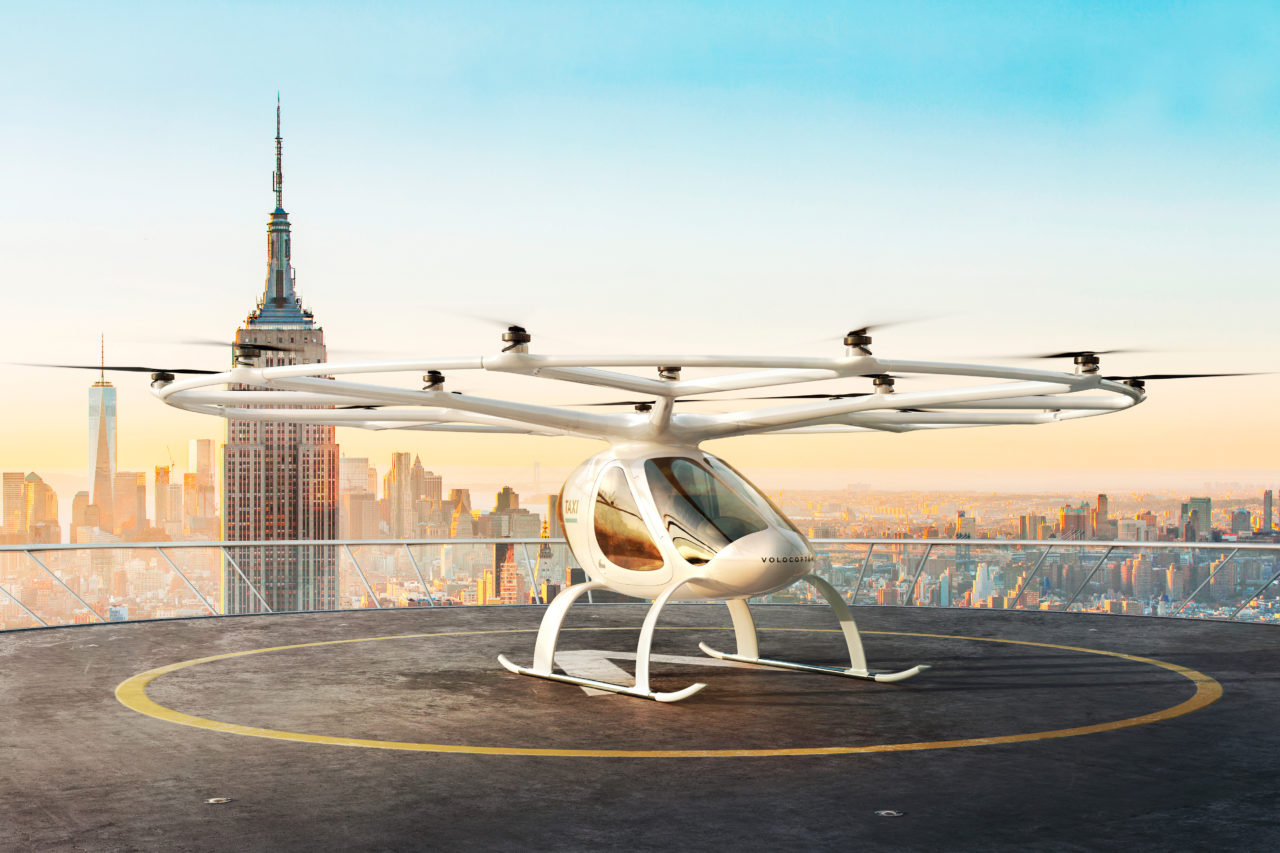
Imagery of a Volocopter in New York. (Volocopter)
Air taxi-maker Volocopter released a whitepaper on the challenges facing the urban air mobility (UAM) market in whcih CTO Jan-Hendrik Boelens finds that those concerns are largely well-addressed by the eponymous Volocopter air vehicle.
The primary issues are nothing new, though the company’s approach isn’t always typical.
- Safety and certification
- Noise
- Range and speed
- Operating cost
- Number of seats
- Design and usability
Volocopter’s electrical vertical-takeoff-and-landing offering is a small two-seater featuring 18 propellers placed around a strutted ring over the cabin. This design, which increases simplicity by giving the propeller motors the freedom to change only the speed of rotation, helps deal with both noise and safety: The small rotors are supposed to produce a fraction of the noise of the quietest helicopters, according to the company, and even multiple motor failures won’t stop the vehicle from completing its mission, providing a level of built-in redundancy. From a distance of 100 feet, a Volocopter landing creates about 76 decibels — only slightly more than the 73 created by average road noise in New York, according to the whitepaper.
Overall, while Volocopter’s vehicle wouldn’t meet Uber’s requirements as a two-seater, the two companies have a similar mindset in advocating simplicity. The simpler something is, the less there is that can go wrong. That means it is safer and easier to certify — and cheaper and faster to replace.
The key to combating noise — a public acceptance obstacle — is slowed rotor tip speeds and disc loading and a high rotor blade area relative to vehicle weight, which the Volocopter accomplished through its quantity of small rotors.
“The above holds true in the critical vertical take-off and landing phase, where the distance to people on the ground is smallest,” the whitepaper says. “In cruise flight at sufficient speed, generating lift using wings may be an efficient way to reduce noise signature, although vertical noise emissions by conventional propellers may negate part of this advantage.”
The issues of range, speed and number of seats are largely tied up in goal mission. Boelens concludes that “there is no single ‘best’ eVTOL concept, because mission is paramount when designing electrically powered aircraft.”
Volocopter’s goal, like many exploring early UAM, is to start with short-range commuting in major cities with traffic problems. The company believes that by restricting routes to an even shorter range than competitors like Uber, they can produce the best business case and create a market that requires “limited infrastructure.”

Want more eVTOL and air taxi news? Sign up for our brand new e-letter, “The Skyport,” where every other week you’ll find the most important analysis and insider scoops from the urban air mobility world.
Most megacities, according to the report, have an urban area spanning less than 20 miles around the geographic center. In 70 percent of cases, there is a major airport within 12.5 miles of the city center, and at 18.5 miles that number jumps to 93 percent. São Paolo, Mumbai, Tokyo, Shanghai and New York are particularly densely populated cities within that radius that would be ripe for trips within that range, according to analysis performed by Volocopter.
While some makers are looking at cruise speeds in the 150 mph-plus range, Volocopter is targeting 50-60. The company’s research revealed that, at the distances they plan to travel, that speed can still save significant time and only get passengers there a few minutes more slowly than traveling at the faster speed. Volocopter says going slower also helps mitigate noise and collision risks with drones and birds, ensuring safe, quiet, low-cost operation that still completes its mission.
One of the big questions surrounding the UAM market is how many seats a vehicle needs. Uber says it needs at least four or five to amortize costs, especially if one seat is going to be filled with a pilot. Arbus’ Vahana has one. Volocopter chose two seats, which Boelens calls “one of the key design drivers.”
While he admits that there are reasons for a bigger cabin, he notes that that extra room — and the associated weight and power requirements — are a drag if you can’t fully utilize it. A 2016 NASA study references road data showing an average load factor of 1.3 people in cars, which it finds similar for conventional-takeoff-and-landing air taxis. As such, Volocopter is opting to put a number if seats it can be fairly confident it can fill in its vehicle, rather than five seats, most of which the company believes will often go unused, or requiring passengers to wait for a full taxi, defeating the purpose of the service.
Did you enjoy this story? We’ll soon be launching a newsletter focused just on UAM and eVTOL content! Stay tuned for more information on how you can stay up-to-date on all the news in this evolving sector.